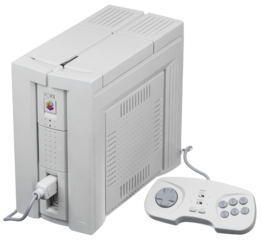PC-FX
From NEC Retro

| ||||||||||

| ||||||||||
| PC-FX | ||||||||||
|---|---|---|---|---|---|---|---|---|---|---|
| Manufacturer: NEC Home Electronics | ||||||||||
|
This short article is in need of work. You can help NEC Retro by adding to it.
The PC-FX (ピーシー エフエックス) is a video game console created by NEC Home Electronics and Hudson Soft as a successor to the PC Engine and its many add-ons and derivatives. After a protracted development timeline, it was released in Japan in December 1994.
Contents
Hardware
The PC-FX stands as a curious mid-point between traditional early-90s video game consoles and desktop computers (of which NEC already had a healthy stake in with the PC-9800 series line). It resembles a typical upright (albeit smaller) mid-90s PC, however is designed to play video games shipped on CD-ROMs with a traditional, six-button controller - the FX-Pad.
The PC-FX is larger than most systems, however, and was some degree intentional, with wasted space to allow the system to "stand-out" in the market place[1] (and completely enclose any future accessories or add-ons, much like the cards in a PC).
The CD drive is located on the top of the unit (a design also witnessed in the PC-8801 MC), and the console is designed to be expandable. No keyboard was ever manufactured for the PC-FX, meaning it was never suited to traditional office software such as word processing, but a mouse was created in the form of the FX-MOU, primarily used for strategy games. The PC-FX can be linked up to a PC-9800 series to act as a CD-ROM drive, however.
NEC chose not to go down the 3D polygon route, instead relying on technology that could decompress full-screen JPEG images at 30FPS from a double-speed CD-ROM drive, separate from the main CPU. This allowed the system to stream video faster than its competitors, creating animated worlds without the need for further processing.
Technical specifications
History
Development
Development on a successor to the PC Engine began in around 1990[2], initially, as with much of the PC Engine's technology, as a project led by Hudson Soft.
A 32-bit "HuC62" machine was first announced at a 20th anniversary event for Hudson in May 1992 at the Imperial Hotel in Tokyo, using five custom-made processors[3] to manipulate graphics; a "HuC6261 Color Palette Video Interface", "HuC6271 Full Color Animation Decoder", "HuC6272 Data Transmitter", "HuC6230 Sound Decoder Mixer" and most importantly a "HuC62320" 32-bit RISC CPU.
Little was said at this stage about the system's potential to play games; rather that it was a "multimedia" device applicable to computer-generated animation and presentations. A prototype was constructed, consisting of a large PCB, plenty of video and audio outputs, but hard-wired inputs, resembling more of a motherboard for a PC or arcade system than a video game console. A decision on what sort of physical media would be used for software had also not been made at the time.
By Summer CES 1992, NEC had come on board, and the project was being referred to as "Tetsujin" ("Iron Man"). NEC saw it as a means of clawing back Japanese video game market share once held by the PC Engine prior to the release of the dominating Super NES, and began talking of Tetsujin's credentials as a video game console.
Nevertheless, there was still an emphasis on its capabilities of displaying high resolution, 24-bit colour graphics[4]. Interest was raised by a demonstration of Super Star Soldier 3D, showing that the system was capable of rendering flat-shaded polygonal 3D graphics. Hudson's demo pre-dated many of the games credited with bringing 3D gaming to the masses, such as 1993's Virtua Fighter which would define the Sega Saturn for a short while.
Though there were rumours of a 1993 release, the Tetsujin project went quiet, and after announcements concerning the Sega Saturn and PlayStation, was re-worked from the ground up[3], becoming project "FX" in early 1994. NEC planned to launch and sell 800,000 FX systems in 1994[5],
Unlike its rivals which reacted by adding more capabilities to their systems, NEC chose a radically different path, reducing the FX to a single CPU[3] (alongside other unknown changes[2]). This meant a late 1994 release date was also pushed back to 1995[3].
50-60 people worked on the FX project (both from a design and engineering point of view)[2]. Hudson Soft continued to be involved in the PC-FX's development, having a say in the manufacture of some components[2], but the single CPU was now a NEC-born V810.
NEC was now planning to sell 50,000 consoles in Japan per year[6]. The PC-FX was never planned to replace the PC Engine outright (the PC Engine Duo-RX becoming the "standard" PC Engine configuration in 1994), but was to be a higher-end unit with its own selection of software.
Similar to the delays imposed on the Sega Saturn and PlayStation, NEC were cautious about releasing the system in North America due to fears the system would cost too much[2]. In the end, no PC-FX systems were officially released outside of Japan.
Release
Legacy
The PC-FX was considered by the Japanese public to be an expensive and underpowered system. Its lack of native 3D capabilities put it at a disadvantage against the Sega Saturn and Sony's PlayStation which had debuted in the same holiday season, and the console was largely shunned by third-party developers as a result. Only a hundred thousand units were produced as opposed to the millions of PC Engines, and the system did not leave Japan in any form, with even NEC citing price as a concern in Western markets.
Despite initial claims to the contrary, NEC imposed unusual directives on PC-FX developers, with software being skewed towards popular anime series with pre-rendered animated footage[7]. Throughout the system's life, virtually all software released for the machine capitalised on its ability to stream video (and load high quality stills) from CD.
While polygonal 3D titles had been demonstrated with Super Star Soldier 3D, no 3D games were ever released on the PC-FX. Tetsuya Iguchi of NEC claimed that a 3D polygon processor would have been too expensive[8], and NEC were not confident that polygons would be the future of video games, seeing the low polygon counts of 1993 as visually unattractive, instead preferring the idea of streaming 2D content very quickly off a disc, to the point where animations could be displayed without further processing by the CPU[8].
NEC's vision for gaming also saw a decline in "arcade-style" games, favouring higher resolution, PC-style releases[1]. Video CD playback was also not considered a priority[1], despite its popularity in parts of Asia.
The company's selective approach to the gaming market, as well as a high asking price led to struggling PC-FX sales from the outset. While billed as a multimedia machine, in its base state the PC-FX can only run proprietary software, audio CDs and the generally unpopular photo CD format, and its comparatively weak specifications meant it was unable to compete on the video game front. Aside from first-party development from NEC Home Electronics, NEC Avenue, Hudson Soft and HuneX, very few developers supported the system, and none were based outside of Japan.
In early 1998 the console was discontinued, and NEC effectively left the home console business.
List of games
- Ah Megami-sama
- Akazukin Cha Cha: O Sawagase Panic Race
- Albaria no Otome
- Angelique Special
- Angelique Special 2
- Angelique Tenkuu no Chinkonka
- Anime Freak FX Vol. 1
- Anime Freak FX Vol. 2
- Anime Freak FX Vol. 3
- Anime Freak FX Vol. 4
- Anime Freak FX Vol. 5
- Anime Freak FX Vol. 6
- Battle Heat
- Blue Breaker: Ken yorimo Hohoemi wo
- Boundary Gate: Daughter of Kingdom
- Can Can Bunny Extra DX
- Chip-chan Kick!
- Choujin Heiki Zeroigar
- Cocktail Pack
- Comic Road
- Cutey Honey FX
- Der Langrisser FX
- Doukyuusei 2
- Dragon Knight 4
- Farland Story FX
- Fire Woman Matoigumi
- First Kiss Monogatari
- Fushigi no Kuni no Angelique
- Ginga Ojousama Densetsu Yuna FX: Kanashimi no Siren
- Hataraku Shoujo: Tekipaki Working Love FX
- J.B. Harold Blue Chicago Blues
- Kishin Douji Zenki FX: Vajura Fight
- Kokuu Hyouryuu Nirgends
- Konpeki no Kantai
- Last Imperial Prince
- Luli La Lula
- Lunatic Dawn FX
- Mahjong Gokuu Tenjiku
- Makeruna! Makendou Z
- Megami Tengoku II
- Minimum Nanonic
- Miraculum: The Last Revelation
- Ojousama Sousa Mou
- Pachio-kun FX: Maboroshi no Shima Daikessen
- Pia Carrot e Youkoso!!
- Power Dolls FX
- Return to Zork
- Ruruli Ra Rura
- Shanghai: Banri no Choujou
- Sotsugyou II Neo Generation FX
- Sotsugyou R: Graduation Real
- Sparkling Feather
- Super Power League FX
- Super Real Mahjong P.V FX
- Team Innocent: The Point of No Return
- Tenchi Muyou! Ryououki FX
- Tengai Makyou: Dennou Karakuri Kakutouden
- Tokimeki Card Paradise: Koi no Royal Straight Flush
- Tonari no Princess Rolfee
- Voice Paradise
- Wakusei Koukitai Little Cats
- Zen Nihon Joshi Pro Wrestle Queen of Queens
- Zoku Hatsukoi Monogatari: Shuuga Kuryokou
Magazine articles
- Main article: PC-FX/Magazine articles.